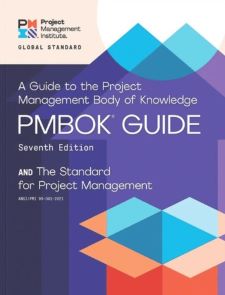
All projects have stakeholders. If they didn’t, the project wouldn’t exist. As a minimum, the project sponsor is a stakeholder who is expecting to receive the project’s deliverables. Usually there are expectations to receive them at a certain time, cost, quality level, or other criteria as well.
The project manager must know who the stakeholders are and actively manage their expectations. You would be surprised how many project issues have arisen because of stakeholders that were ignored because they were considered minor. But those minor stakeholders can trip up a project just like a major one can.
The Project Stakeholder Performance Domain breaks down into the following five general basic components of stakeholder management:
- Stakeholder Identification
The initial step involves recognizing all individuals, groups, or organizations that could impact or be impacted by the project. Tools like stakeholder registers are used to document who these stakeholders are. - Stakeholder Analysis
This process assesses stakeholder interests, influence, expectations, and potential impact on the project. Techniques include stakeholder mapping and power/interest grids to categorize stakeholders based on their power and interest. - Stakeholder Engagement Planning
Creating strategies to effectively engage with stakeholders. This includes prioritization of the most important stakeholders, and development of communication plans that specify how, when, and with what frequency stakeholders will be informed or consulted. - Stakeholder Engagement
During project execution, the actual interactions with stakeholders are made. Ensure their needs are addressed, conflicts are resolved, and support for the project is maintained. This includes regular meetings, updates, and feedback sessions. - Stakeholder Monitoring and Control
Continuously evaluating the effectiveness of engagement strategies. This involves gathering feedback, measuring stakeholder satisfaction, and adjusting engagement tactics as needed to respond to changes in stakeholder dynamics or project conditions.
The first three take place during project planning, and the last two during execution.
The PMBOK utilizes Models, Methods and Artifacts to accomplish project goals. The stakeholder performance domain includes the following in each category.
Models
There are 10 models that are associated with the project stakeholder performance domain in the PMBOK:
- Cross-cultural communication
- Effectiveness of communication channels
- Gulf of execution and evaluation
- Managing Change in Organizations
- ADKAR
- 8-Step Process for Leading Change
- Transition
- Conflict
- Negotiation
- Salience
Methods
The following 15 methods are associated with the project stakeholder domain in the PMBOK:
- Stakeholder Analysis
- Backlog refinement
- Bidder conference
- Daily standup
- Iteration review
- Iteration planning
- Kickoff
- Lessons learned
- Project closeout
- Project review
- Release planning
- Steering committee
- Impact mapping
- Net Promoter Score
- Prioritization schema
Artifacts
The following 13 artifacts are included with the stakeholder performance domain within the PMBOK:
- Stakeholder Engagement Plan
- Organizational breakdown structure
- Prioritization matrix
- Stakeholder Engagement Assessment Matrix
- Fixed-price Contract
- Cost-reimbursable Contract
- Time and materials Contract
- Indefinite time indefinite quantity (IDIQ) Contract
- Other agreements
- Activity list
- Bid documents
- Requirements documentation
- User story
The Project Stakeholder Management knowledge area has four processes:
- Identify Stakeholders
- Plan Stakeholder Engagement
- Manage Stakeholder Engagement
- Monitor Stakeholder Engagement
Identify Stakeholders
The first step to ensuring that all stakeholders of a project are satisfied is to identify them. In fact, the Identify Stakeholders process is so fundamental to a project’s existence that the PMBOK specifies only it and the Project Charter in the Project Initiation process group. In other words, the major project stakeholders are identified prior to the project being incorporated. A project is initiated with the major stakeholders in mind.
In addition to the major stakeholders, there are almost always minor ones who don’t seem significant but have an outsized ability to create project issues relative to their financial stake in it.
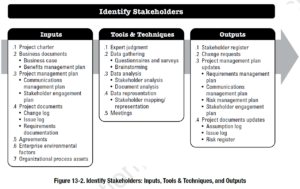 Inputs
Inputs
- Project charter
- Business documents
- Business case
- Benefits management plan
- Project management plan
- Communications management plan
- Stakeholder engagement plan
- Project documents
- Change log
- Issue log
- Requirements documentation
- Agreements
- Enterprise environmental factors
- Organizational process assets
Tools & Techniques
- Expert judgment
- Data gathering
- Questionnaires and surveys
- Brainstorming
- Data analysis
- Stakeholder analysis
- Document analysis
- Data representation
- Stakeholder mapping/representation
- Meetings
Outputs
- Stakeholder register
- Change requests
- Project management plan updates
- Requirements management plan
- Communications management plan
- Risk management plan
- Stakeholder engagement plan
- Project documents updates
- Assumption log
- Issue log
- Risk register
Plan Stakeholder Engagement
The Stakeholder Management Plan, a component of the overall Project Management Plan, is created to specify how the project will interact with each stakeholder. It identifies and analyzes two items for each stakeholder: The level of interest the stakeholder has in the project, and their ability to control it. Also, the stakeholder’s technical knowledge can be a major factor to plan for up front. All stakeholder concerns are presented and analyzed to ensure the project is set up for success.
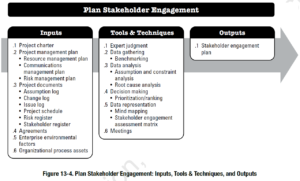 Inputs
Inputs
- Project charter
- Project management plan
- Resource management plan
- Communications management plan
- Risk management plan
- Project documents
- Assumption log
- Change log
- Issue log
- Project schedule
- Risk register
- Stakeholder register
- Agreements
- Enterprise environmental factors
- Organizational process assets
Tools & Techniques
- Expert judgment
- Data gathering
- Benchmarking
- Data analysis
- Assumption and constraint analysis
- Root cause analysis
- Decision making
- Prioritization/ranking
- Data representation
- Mind mapping
- Stakeholder engagement assessment matrix
- Meetings
Outputs
- Stakeholder engagement plan
Manage Stakeholder Engagement
Throughout the project the stakeholders are consulted to ensure their needs are met. Stakeholder interactions are executed according to the Stakeholder Management Plan, and changes to the plan are made as necessary.
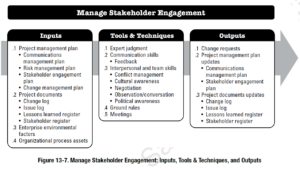 Inputs
Inputs
- Project management plan
- Communications management plan
- Risk management plan
- Stakeholder engagement plan
- Change management plan
- Project documents
- Change log
- Issue log
- Lessons learned register
- Stakeholder register
- Enterprise environmental factors
- Organizational process assets
Tools & Techniques
- Expert judgment
- Communication skills
- Feedback
- Interpersonal and team skills
- Conflict management
- Cultural awareness
- Negotiation
- Observation/conversation
- Political awareness
- Ground rules
- Meetings
Outputs
- Change requests
- Project management plan updates
- Communication management plan
- Stakeholder engagement plan
- Project documents updates
- Change log
- Issue log
- Lessons learned register
- Stakeholder register
Monitor Stakeholder Engagement
As part of the Monitoring & Controlling process group, this process must be executed on regular intervals throughout the project to assess the effectiveness of the Stakeholder Management Plan. Although specific actions are not as well defined as other M&C processes, this could include reviewing stakeholder communications, gathering information about them, or even asking them directly how they feel about the project and/or their specific concern.
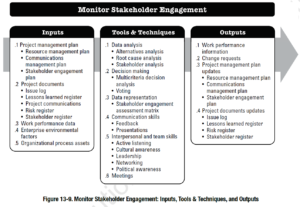 Inputs
Inputs
- Project management plan
- Resource management plan
- Communications management plan
- Stakeholder engagement plan
- Project documents
- Issue log
- Lessons learned register
- Project communications
- Risk register
- Stakeholder register
- Work performance data
- Enterprise environmental factors
- Organizational process assets
Tools & Techniques
- Data analysis
- Alternatives analysis
- Root cause analysis
- Stakeholder analysis
- Decision making
- Multicriteria decision analysis
- Voting
- Data representation
- Stakeholder engagement assessment matrix
- Communication skills
- Feedback
- Presentations
- Interpersonal and team skills
- Active listening
- Cultural awareness
- Leadership
- Networking
- Political awareness
- Meetings
Outputs
- Work performance information
- Change requests
- Project management plan updates
- Resource management plan
- Communications management plan
- Stakeholder engagement plan
- Project documents updates
- Issue log
- Lessons learned register
- Risk register
- Stakeholder register



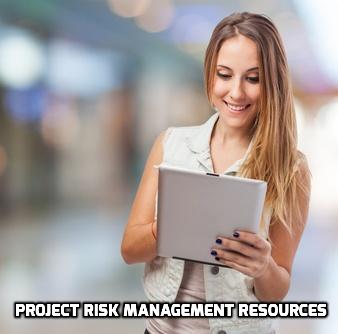

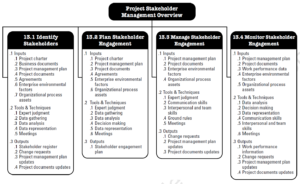

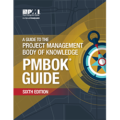

 Manley Haye says
Manley Haye says
July 11, 2017 at 10:38 pmIt is not absolutely clear to me, what the real distinction between
Manage stakeholder engagement and
Control stakeholder engagement.
I would greatly appreciate some further guidance/literature/examples etc.
 Berb says
Berb says
September 18, 2018 at 1:40 pmI agree. It would be nice if someone could spell this out a little better.
I’m studying for the test and I noticing HUGE holes left to interpretation; which makes ZERO sense for a test that is based on a time tested and well documented process.
 Mary says
Mary says
July 14, 2019 at 3:18 pmManage Stakeholder Engagement involves communicating as well as working together with the stakeholders to meet their expectations and needs. This process also addresses the different issues of project management as they occur. Moreover, it also fosters the engagement of stakeholders in the many activities throughout the life cycle of a project.
Monitor Stakeholder Engagement implies comparing stakeholder management plan against actual stakeholder engagement to investigate variances and change the plan accordingly to ensure the stakeholders’ continued engagement in the project. It is the process of monitoring project stakeholder relationships and tailoring strategies for engaging stakeholders through modification of engagement strategies and plans.The key benefit of this process is that it maintains or increases the efficiency and effectiveness of stakeholder engagement activities as the project evolves and its environment changes.